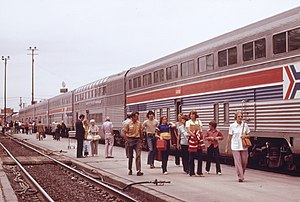| Hi-Level | |
|---|---|
 Hi-Level coaches on Amtrak's Southwest Limited at Albuquerque in 1974; the lounge is second from right. | |
 The interior of an Amtrak Pacific Parlour Car, a refurbished lounge | |
| In service | 1954–2018 |
| Manufacturer | Budd Company |
| Constructed | 1952–1964 |
| Number built | 73 (61 coaches, 6 lounges, 6 diners) |
| Number preserved | Various in private ownership |
| Capacity |
|
| Operators | |
| Specifications | |
| Car body construction | Stainless steel |
| Car length | 85 feet (26 m) |
| Height | 15 feet 6 inches (4.72 m) |
| Weight |
|
| Notes/references | |
| [1] | |
The Hi-Level was a type of bilevel intercity railroad passenger car used in the United States. Car types included coaches, dining cars, and lounge cars; a sleeping car variant was considered but never produced. Most passenger spaces were on the upper level, which featured a row of windows on both sides. Boarding was on the lower level; passengers climbed up a center stairwell to reach the upper level. Vestibules on the upper level permitted passengers to walk between cars; some coaches had an additional stairwell at one end to allow access to single-level equipment.
The Budd Company designed the car in the 1950s for the Atchison, Topeka and Santa Fe Railway ("Santa Fe") for use on the El Capitan, a coach-only streamliner which ran daily between Los Angeles and Chicago. The design was inspired by two recent developments in railroading: the dome car, employed in intercity routes in the western United States, and bilevel commuter cars operating in the Chicago area. Budd built 73 Hi-Level cars between 1952 and 1964.
The first two prototype coaches entered service on the El Capitan in 1954 and were immediately successful. Budd built sufficient coaches, dining cars, and lounge cars to fully equip the El Capitan, with additional coaches seeing use on the San Francisco Chief. Amtrak inherited the entire fleet in 1971 and continued to use the equipment on its western routes. Tunnel clearances restricted their use in the eastern United States. In 1979, the first Superliners, based on the Hi-Level concept although built by Pullman-Standard, entered service. Amtrak gradually retired most of its Hi-Levels in the 1990s as more Superliners became available. Five lounges, dubbed "Pacific Parlour Cars", provided first-class lounge service on the Coast Starlight until their retirement in 2018.